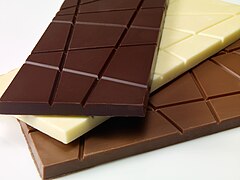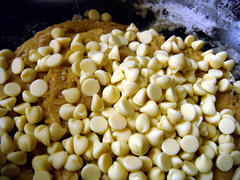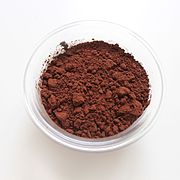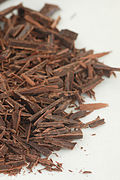Cookbook:Chocolate
| Chocolate | |
|---|---|
 |
Cookbook | Recipes | Ingredients | Equipment | Techniques | Cookbook Disambiguation Pages | Ingredients | Basic Foodstuffs | Ingredients Index
Chocolate is an ingredient made from the fermented, roasted, and ground seeds of the tropical cacao tree.[1]
Production
[edit | edit source]The production of chocolate is a long process, the entirety of which takes place across long distances and several steps.[2]

Fermentation
[edit | edit source]After harvesting, the cacao pods are cut open and the pulp-covered seeds removed. These seeds are then piled on mats or in boxes to allow a several-day fermentation process that breaks down the pulp and develops some of the characteristic flavors and colors of chocolate.[1][2][3][4] The first stage of fermentation yields heat, as well as lactic and acetic acids, which combine to weaken the cacao seed shell and penetrate inside the seed.[2] The endemic enzymes in the seed combine with those of the microbes to break the proteins and sugars, yielding complex flavor and aroma molecules.[2][4] During the entire fermentation process, the seeds are turned regularly to allow even fermentation.[1][2]

Drying
[edit | edit source]After being cleaned of any residual pulp, the seeds enter next stage.[3] Here, the seeds are spread out in a thin layer to fully dry out over the course of several weeks until they reach 5–8% moisture.[2][3] At this point, they are still quite vinegary and don't have any noticeable chocolate character.[2] The seeds are then transferred from the farmers to chocolate manufacturers.
Roasting
[edit | edit source]Once at the manufacturer, the seeds begin to adopt the characteristics we associate with chocolate.[1] Here, they are roasted to kill any remaining microbes and develop characteristic chocolate flavor.[4] The heat of the oven (250–320°F / 120–160°C) evaporates any residual ethanol and vinegar and induces the Maillard reaction,[2] which causes even more complex flavor compounds to develop.[2][3][4] The exact degree of roasting will depend on the desired characteristics and manufacturer specifications.[5] After roasting, the seeds are cracked to isolate the nib from the shell.[1][2][5]
Grinding and pressing
[edit | edit source]Much like with the production of nut butters, the roasted cacao seeds are then ground.[6] This releases a paste called chocolate liquor or mass, which contains both cocoa butter (a fat) and cocoa solids.[2][3][7] The liquor is about 50–55% cocoa butter, with the remainder consisting of carbohydrates, proteins, and flavor compounds.[2][5] It is quite bitter and will solidify when cooled.[1]
After grinding, chocolate liquor may undergo a pressing step, which separates most of the cocoa butter from the cocoa solids.[1][2] These solids can be ground to make cocoa powder.[6][7]
Formulation
[edit | edit source]To produce the final chocolate, cocoa liquor and/or solids are blended to a manufacturer's specifications with cocoa butter, sugar, flavorings, milk solids, and/or emulsifiers.[1][5] Because cocoa butter is what keeps the chocolate smooth and emulsified, additional emulsifiers are needed to produce low-fat chocolate.[2] Some manufacturers—especially American ones—will add butyric acid, which adds a characteristic tangy flavor.[2]

Conching
[edit | edit source]One of the final steps in the chocolate-making process is conching, where the chocolate is heated and ground for an extended period of time to further reduce the particle size, even out the texture, and mellow the flavor.[2][5] The finer the chocolate is ground, the lower the viscosity and the smoother the mouthfeel.[1][4]
Tempering
[edit | edit source]In order to create an appealing and snappy texture when solid, melted chocolate must finally be treated in a process called tempering.[5][6][7] Tempering controls the formation of cocoa butter crystals to yield firm crystals with a good texture and relatively high melting temperature.[8] Every time solid tempered chocolate is melted, it must be re-tempered or it will lose these properties. Once tempered, the chocolate is molded or otherwise shaped, then cooled.[5]
Characteristics
[edit | edit source]Different cultures and regulatory bodies will have slightly different regulations for chocolate that govern the final properties.[2][8] However, all chocolate shares the same broad characteristics.
Color
[edit | edit source]Depending on the proportion of cocoa solids, chocolates are anywhere from tan to brown to black. White chocolate, which contains no cocoa solids, is white or cream-colored.[6]
Flavor
[edit | edit source]Chocolate's characteristic flavor is attributed to around 200–600 different aromatic compounds that develop during the cacao's growth and complex production process.[2][4] For example, three primary cacao cultivars exist, all with slightly different characteristics. Additionally, the growing location and conditions will affect the flavor profile due to both the development of the cacao, as well as the specific microbes endemic to the region.[4][9] In order to develop a signature chocolate flavor, a manufacturer will blend different varieties of cacao seeds to take advantage of the differences inherent to their different origins.[4][5]
Pure chocolate is very flavorful but very bitter and somewhat acidic.[2] The addition of milk contributes further flavors, especially if it has undergone heating to yield additional flavorful Maillard byproducts.[4] Vanilla adds a floral character,[9] and other additions will further diversify the flavor.
Texture
[edit | edit source]The texture of chocolate is dependent largely on its particle size and fat content.[10] These affect the melting point and overall fluidity of the liquid chocolate, as well as the mouthfeel. The smaller the particle size, the smoother the chocolate feels to the tongue, and the fact that cocoa butter melts at body heat gives it a luxurious texture without greasiness.[6][11] The higher the cocoa butter proportion, the smoother and meltier it will feel.[6] Notably, European chocolates are very smooth, while American chocolate has a grainier texture.[5]
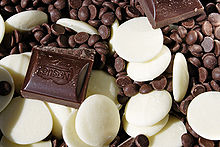
Forms
[edit | edit source]Solid chocolate can come in a variety of different forms, used for different purposes. Chocolate bars are commonly sold in bars of different weights. They are usually molded with grooves so that individual pieces may be broken off. Chocolate bars may also contain inclusions, such as nuts, fruits, pretzels, etc. Chocolate chips are small chunks of sweet chocolate, often stabilized and sold in a round, flat-bottomed teardrop shape.[5][11] They are known for their use in chocolate chip cookies. Chocolate may also be shaped into specialty forms.
Varieties
[edit | edit source]
A number of different chocolate varieties are commercially available, differing based on their component ratios and level of processing. Chocolates are often described with a cacao percentage, which reflects the percentage of the chocolate that comes from cacao beans (i.e. cocoa solids and butter) as opposed to additional ingredients.[9] However, it is important to note that the cocoa percentage does not tell you the specific respective percentages of cocoa solids versus cocoa butter—these are up to the manufacturer. So, you could have two 70% cocoa bars with different properties and degrees of chocolate flavor due to variation in the specific components.[12][9] Some manufacturers will give specific component breakdowns,[12] but if they do not, it's worth looking at the nutritional breakdown to get an approximation.
Unsweetened or baking chocolate
[edit | edit source]Unsweetened or baking chocolate is simply the pure chocolate liquor with nothing added, making it 100% cacao.[5] It contains both cocoa solids (~47%) and cocoa butter (~53%).[5] It has a very bitter flavor so is not often eaten plain, but it is used in baking.[2][5]
Dark chocolate
[edit | edit source]Dark chocolate is composed of chocolate liquor with varying degrees of added sugar. It is sometimes called plain chocolate. Bittersweet and semisweet chocolates are the next step down from unsweetened—they tend to have over 35% cacao, though the exact level varies according to the manufacturer and specific formulations.[2][5][7] The next step down, called sweet chocolate, contains at least 15% cacao.[5][7]
Milk chocolate
[edit | edit source]Milk chocolate consists of chocolate liquor with both milk solids and sugar added.[5] The U.S. government requires 10% concentration chocolate liquor, and European rules specify a minimum of 25% cocoa solids.[3][7] Milk solids content is often over 12%.[9] The addition of milk provides a milder and creamier flavor,[2] and it can contribute a nutty flavor, especially if cooked milk crumb is used. The milk solids can also be browned when the chocolate is heated. Generally, milk chocolate has a softer texture since the milk content often reduces the proportion of cocoa butter in the chocolate.[9]
White chocolate
[edit | edit source]White chocolate is a product containing cocoa butter (>20%), milk solids, and sugar, but without cocoa solids—as such, it is often not considered "true" chocolate.[2][3][7] However, since it has a large cocoa butter component, it has many of the same textural and behavioral properties as other chocolates.[3] Imitation products may be made even without cocoa butter, meaning that they have no cacao content at all—these may be referred to as "white coating" or "white chips" and are generally regarded as an inferior product.
Blond chocolate
[edit | edit source]Blond or "caramelized" chocolate is white chocolate that has been gently roasted before tempering in order to allow the Maillard reaction to occur.[13][14] This results in a toffee color and more complex nutty flavor than standard white chocolate.[13] It otherwise has the same properties as white chocolate.
Ruby chocolate
[edit | edit source]This chocolate is a proprietary variety that has a pinkish-purple color and sour fruity flavor. The developer has not released exactly how it is made, but it is largely assumed that ruby chocolate comes from un- or under-fermented cacao beans that have been treated with acids.[15][16][17]
Couverture
[edit | edit source]The term "couverture" (literally "covering") can be applied to any of the above chocolates,[5] and it refers to chocolates that have at least 32% total cocoa butter content.[18] This gives the chocolate greater fluidity when melted, which allows it to create a thinner layer when used as a coating.[1][3][5]
Modeling chocolate
[edit | edit source]Modeling chocolate is chocolate that has been combined with invert sugars, which makes it into a plastic paste.[1][5] This plastic texture allows it to be used in a similar way to marzipan, fondant, or sugar paste in order to make edible chocolate-flavored sculptures and decorations.[1][5]
Imitation chocolate
[edit | edit source]Also called confectionery coating, imitation chocolate contains cocoa solids but no cocoa butter at all, usually being made instead with vegetable fats.[7] It is generally considered lower quality and is not recommended for use in cooking due to issues with flavor and texture.[18]

Cocoa powder
[edit | edit source]Cocoa powder is the unsweetened powdered, reddish cocoa solids left after the cocoa butter is pressed from the chocolate liquor. It is quite acidic and bitter,[2][11] and it is often used in baking since melting is not required.[18] Natural cocoa powder may subsequently be "Dutched" or treated with alkali, which makes the powder darker and less acidic,[5][6][7] and a given amount of Dutched cocoa tastes more chocolatey than the same amount of unprocessed cocoa.
Selection and storage
[edit | edit source]To evaluate the general quality of chocolate, you can judge it by a few factors. Higher quality chocolates are generally snappy in texture, even in melt, and smooth and shiny with no discoloration.[5] As a general rule, elite cocoa makers (e.g. Hershey, Nestle) make good-but-not-excellent chocolate, and elite chocolate makers (e.g. Scharffen Berger, Ghiradelli) make good-but-not-excellent cocoa. You'll also want to make sure the characteristics of the chocolate (e.g. cacao, fat, milk, sugar contents) match your application—differences exist between brands.
Chocolate is very sensitive to temperature and humidity. Ideal storage temperatures are between 15 and 17°C (59–63°F), with a relative humidity of less than 50%.[9] As it can absorb different aromas, chocolate should be stored away from other foods. Additionally, chocolate should be protected from light by storing in a dark place or wrapping in paper. The shelf life is quite long, but the fats will eventually go rancid.[11] Milk-containing chocolate keeps less well due to additional chemical reactions that will still take place.[6]
Various types of white "blooming" effects on the surface of chocolate can occur if chocolate is stored or served improperly. If refrigerated or frozen without proper containment, chocolate can encounter enough moisture to cause sugar bloom, a whitish discoloration from sugar crystals rising to the surface.[4][8] Fat bloom occurs when the cocoa butter melts and recrystallizes. Although visually and texturally unappealing, these conditions are perfectly safe for consumption[2][7]—in particular, textural issues from fat bloom can be remedied by simply retempering the chocolate.
Techniques
[edit | edit source]Handling
[edit | edit source]Because chocolate melts at body temperature, it is important to work in a cool area when handling chocolate. Using gloves can also provide a slight barrier to mitigate transfer of heat from your hands to the chocolate.[9]
Melting
[edit | edit source]
In many applications, chocolate must be melted before use, and this must be done carefully. Chocolate is prone to scorching when overheated, which turns the texture thick and lumpy—there is no fixing this once it has happened.[6][7] Melted chocolate is also particularly sensitive to small amounts of water contamination. This is because small amounts of water—even a drop—draw the sugar out of suspension from the cocoa butter, causing the mixture to seize and separate.[2][6][7][8] This, too, is not fixable. However, you can repurpose seized chocolate for something like a ganache—when a larger amount of hot liquid such as cream is added, it sufficiently coats all the particles in the mixture to allow them to flow smoothly again.[2]
To melt chocolate, gentle heat using a double-boiler or low-power microwave bursts is recommended. Using small pieces of chocolate and stirring regularly are a must in order to promote smooth, even melting.[7] If using a bain-marie, make sure no moisture comes into contact with the chocolate.[7]
Ganache
[edit | edit source]As mentioned, a ganache is the result of emulsifying a large amount of hot liquid—usually cream—with chocolate.[2][8] Fluid ganache can be made into mousse or used as a softer chocolate coating than pure melted chocolate, and solidified ganache is often made into a variety of chocolate confections.[7]
Use
[edit | edit source]Chocolate has immense applications across cuisines.
Savory
[edit | edit source]Though often regarded primarily as a sweet food, chocolates can be incorporated into savory dishes. This is especially common as a practice in Mexican and some other indigenous American cuisines, where chocolate makes up a portion of mole sauce.[19] It can in rarer occasions be seen as a component of some Western European sauces and meat dishes.[19]
Patisserie
[edit | edit source]In baked goods, chocolate—and especially cocoa powder—contributes flavor and structure to the final product through its constituent starch, protein, fiber, and fat.[12] As the cocoa solids absorb moisture, they can substitute in part for flours in some applications.[6][9] Chocolate is also used in various creams, puddings, mousses, frostings, and more.[19] Cacao nibs may be incorporated as well, in much the same way as other nuts and seeds.
Confectionery
[edit | edit source]
A variety of chocolate confections exist, ranging from chocolate-coated fruits and nuts to molded shells of chocolate that encase a filling. Dipped confections are made by dipping various tidbits in melted chocolate,[5] while molded ones are made by creating chocolate shells and filling them.[5][20] Truffles are made by shaping ganache and rolling the confections in a dry coating.[5]
Decor
[edit | edit source]Chocolate's textural properties make it immensely useful for decoration and garnish.[1] Tempered chocolate can be readily shaped through piping, spreading, cutting, curling, shaving, and more to create a range of shapes and textures. Melting chocolate and thinning it with cocoa butter makes it analogous to a paint, and this can be combined with a paint sprayer to create velvety chocolate layers on desserts.[1][21]
Beverages
[edit | edit source]From the beginning, chocolate has had applications in beverages. Hot cocoa or hot chocolate is one of the oldest chocolate products, made by combining chocolate with water or milk, and cold chocolate beverages are also common. Chocolate can also be used to flavor liqueurs.
Substitution
[edit | edit source]Very few things can substitute for true chocolate. Imitation products can make an approximation of flavor, but cocoa butter is necessary for characteristic chocolate properties. For those who cannot tolerate cacao products, the carob pod may be processed and ground to create a cocoa powder analog.[22]
Gallery
[edit | edit source]-
Dark chocolate (top), white chocolate (middle), and milk chocolate (bottom)
-
Dark chocolate chips
-
White chocolate chips
-
Cocoa powder
-
Chocolate shavings
-
Solid cocoa butter
-
A box of assorted chocolate candies
Recipes
[edit | edit source]References
[edit | edit source]- ↑ a b c d e f g h i j k l m n Gisslen, Wayne (2016-09-21). Professional Baking. John Wiley & Sons. ISBN 978-1-119-14844-9.
- ↑ a b c d e f g h i j k l m n o p q r s t u v w x y z aa ab Provost, Joseph J.; Colabroy, Keri L.; Kelly, Brenda S.; Wallert, Mark A. (2016-05-02). The Science of Cooking: Understanding the Biology and Chemistry Behind Food and Cooking. John Wiley & Sons. ISBN 978-1-118-67420-8.
- ↑ a b c d e f g h i The Chefs of Le Cordon Bleu (2011-12-02). Le Cordon Bleu Patisserie and Baking Foundations. Cengage Learning. ISBN 978-1-4390-5713-1.
- ↑ a b c d e f g h i j Varelis, Peter; Melton, Laurence; Shahidi, Fereidoon, eds. (2019). Encyclopedia of food chemistry. Vol. 1. Vol. 1. Oxford: Elsevier. ISBN 978-0-12-816848-6.
- ↑ a b c d e f g h i j k l m n o p q r s t u v w x y Labensky, Sarah; Martel, Priscilla; Damme, Eddy Van (2015-01-06). On Baking: A Textbook of Baking and Pastry Fundamentals, Updated Edition. Pearson Education. ISBN 978-0-13-388675-7.
- ↑ a b c d e f g h i j k Figoni, Paula I. (2010-11-09). How Baking Works: Exploring the Fundamentals of Baking Science. John Wiley & Sons. ISBN 978-0-470-39267-6.
- ↑ a b c d e f g h i j k l m n o The Culinary Institute of America (CIA) (2015-02-25). Baking and Pastry: Mastering the Art and Craft. John Wiley & Sons. ISBN 978-0-470-92865-3.
- ↑ a b c d e Farrimond, Stuart (2017-09-19). The Science of Cooking: Every question answered to perfect your cooking. Penguin. ISBN 978-1-4654-7079-9.
- ↑ a b c d e f g h i "Everything You Need to Know About Baking With Chocolate". Serious Eats. Retrieved 2024-03-24.
- ↑ "Chocolate | Cocoa | Baking Ingredients | BAKERpedia". 2015-06-07. Retrieved 2024-03-24.
- ↑ a b c d Amendola, Joseph; Rees, Nicole (2003-01-03). Understanding Baking: The Art and Science of Baking. Wiley. ISBN 978-0-471-44418-3.
- ↑ a b c Iliescu, Olguta (2014-09-19). "Everything you need to know about chocolate". Pastry Workshop (in Romanian). Retrieved 2024-03-24.
- ↑ a b "Blonde Chocolate | What is it and how is it made?". The Chocolate Society. Retrieved 2024-03-24.
- ↑ Vega, Cesar; Ubbink, Job; Linden, Erik van der (2013-08-13). The Kitchen as Laboratory: Reflections on the Science of Food and Cooking. Columbia University Press. ISBN 978-0-231-15345-4.
- ↑ confectionerynews.com (2017-09-14). "Ruby chocolate: New gem in confectionery crown or pink misfit?". confectionerynews.com. Retrieved 2024-03-24.
- ↑ Lee, Peter W. Y. (2024-01-08). "What Is Ruby Chocolate And How Do You Cook With It?". Tasting Table. Retrieved 2024-03-24.
- ↑ Stokes, Susan (2022-08-31). "What is Ruby Chocolate? Everything You Need to Know". ReadCacao. Retrieved 2024-03-24.
- ↑ a b c Stamm, Mitch (2011-07-01). The Pastry Chef's Apprentice: An Insider's Guide to Creating and Baking Sweet Confections and Pastries, Taught by the Masters. Quarry Books. ISBN 978-1-61058-027-4.
- ↑ a b c Davidson, Alan (2014-01-01). Jaine, Tom (ed.). The Oxford Companion to Food. Oxford University Press. doi:10.1093/acref/9780199677337.001.0001. ISBN 978-0-19-967733-7.
- ↑ Goldstein, Darra (2015). The Oxford Companion to Sugar and Sweets. Oxford University Press. ISBN 978-0-19-931339-6.
- ↑ Friberg, Bo (2016-09-13). The Professional Pastry Chef: Fundamentals of Baking and Pastry. Wiley. ISBN 978-0-470-46629-2.
- ↑ "What is Carob and How is it Used?". The Spruce Eats. Retrieved 2024-03-24.
